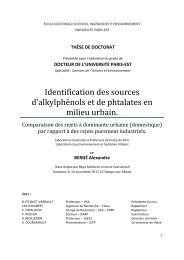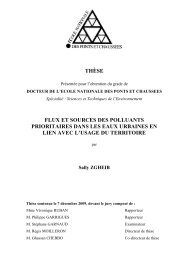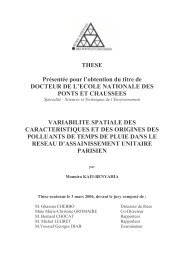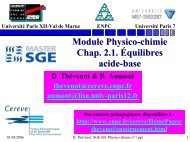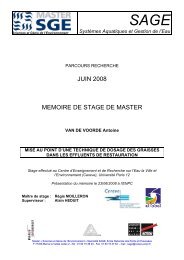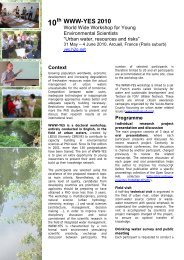urban lake water quality cross research perspectives ... - LEESU
urban lake water quality cross research perspectives ... - LEESU
urban lake water quality cross research perspectives ... - LEESU
You also want an ePaper? Increase the reach of your titles
YUMPU automatically turns print PDFs into web optimized ePapers that Google loves.
9th WWW YES, Belo Horizonte MG, Brazil 26-30 October 2009 – keynote presentation<br />
URBAN LAKE WATER QUALITY<br />
CROSS RESEARCH PERSPECTIVES BETWEEN<br />
BRAZIL AND FRANCE<br />
Brigitte VINÇON-LEITE, Briac LE VU, Bruno LEMAIRE, Sarah JUNG and<br />
Bruno TASSIN<br />
Laboratoire Eau, Environnement et Systèmes Urbains <strong>LEESU</strong> (Université Paris-Est,<br />
AgroParisTech), UMR-MA 102, Ecole des Ponts ParisTech, 6-8 avenue Blaise Pascal,<br />
Cité Descartes, 77455 Marne-La-Vallée Cedex 2, France.<br />
(E-mail: bvl@cereve.enpc.fr)<br />
Keywords<br />
Lake, Phytoplankton; sediment core; PCB; <strong>urban</strong> runoff; real time; monitoring system<br />
ABSTRACT<br />
This paper will present the issue of <strong>water</strong> <strong>quality</strong> monitoring in <strong>urban</strong> <strong>lake</strong>s, at two different time and<br />
space scales. It aims at initiating a reflection about how it could be investigated in a joint French-<br />
Brazilian <strong>research</strong> project. Two topics which will addressed: (1) high-frequency, autonomous monitoring<br />
system of phytoplankton dynamics and (2) <strong>urban</strong> storm <strong>water</strong> monitoring with sediment core analysis.<br />
Lakes located in densely <strong>urban</strong>ized <strong>water</strong>sheds have essential functions for the city dwellers. In the<br />
European Union, aquatic systems are monitored and restored according to the Water Framework<br />
Directive (WFD). In this context, the monitoring programmes have two main objectives: to assess the<br />
ecological status of natural and artificial <strong>lake</strong>s inside homogeneous hydroecoregions and to survey the<br />
effect of restoration measures.<br />
Phytoplankton is a key element for the establishment of the ecological status in <strong>urban</strong> <strong>lake</strong>s: the<br />
composition and biomass of phytoplankton as well as the frequency and intensity of phytoplankton<br />
blooms are to be monitored. Among the phytoplankton groups, the cyanobacteria are specifically targeted<br />
because many species, potentially toxic, can threaten public health and impair the <strong>water</strong> uses.<br />
The commitment of monitoring phytoplankton blooms in the numerous <strong>lake</strong>s requires reliable, costeffective,<br />
easy-to-handle, monitoring systems (Allan et al., 2006; Dworak et al., 2005). High-frequency<br />
monitoring systems are useful, since episodic measurements may not enable the understanding of the<br />
local determinants of ecosystem dynamics (Carstensen, 2007). Autonomous monitoring stations offer<br />
further advantages: (1) for surveying remote sites; (2) for dealing with the scarcity of qualified personnel<br />
to perform sampling, chemical analysis and phytoplankton counting, (3) for reducing the cost due to<br />
repeated analyses.<br />
The monitoring system presented in this paper has been developed within the PROLIPHYC project.<br />
Primarily aimed at assessing phytoplankton growth, it consists in the following items: design of a<br />
fresh<strong>water</strong>-adapted measurement buoy, remote transmission of the data (<strong>water</strong> temperature, Chlorophyll,<br />
Oxygen and meteorological data), automated integration of data into predictive modelling, warning<br />
procedure development. In this paper, the methodology of the project is outlined; the overview and the<br />
implementation of a buoy in the <strong>urban</strong> Enghien Lake (Ile-de-France) are described. An overview of the<br />
collected data during 2009 spring and summer is presented.
9th WWW - YES, Belo Horizonte MG, Brazil 26-30 October 2009 - keynote presentation<br />
On the other hand, <strong>urban</strong> storm<strong>water</strong> runoff is of major concern considering anthropogenic pollution in<br />
receiving <strong>water</strong> bodies. When other sources of pollution, especially waste <strong>water</strong>, are under control, they<br />
turn out to be the main source of pollution in <strong>urban</strong> areas. Urban runoff can be significantly contaminated<br />
by mineral and organic micropollutants originating chiefly from roof and road runoff (Brown and Peake<br />
2006, Davis et al. 2001, Gromaire-Mertz et al. 1999). Yet, the part of <strong>urban</strong> runoff on the contamination<br />
of receiving <strong>water</strong> bodies is still difficult to assess.<br />
Sediment core analysis is an excellent tool to monitor the historical trends of various persistent organic<br />
contaminants. Reconstruction of historical inputs of anthropogenic chemicals is important for improving<br />
management strategies and evaluating the success of recent pollution control measures. In this paper, we<br />
will present the main results obtained on Lake Pampulha’s sediment cores (Jung 2009) with a<br />
methodology firstly developed to evaluate the impact of <strong>urban</strong> runoff on a large French <strong>lake</strong> (Lake<br />
Bourget). Four sediment cores, collected in May 2007 in Lake Pampulha, were analysed for<br />
polychlorobyphenyls (PCB) in order to determine the evolution of the inputs linked to the development of<br />
the <strong>urban</strong>isation on the catchment during the last decades.<br />
REFERENCES<br />
• Allan I, Vrana B, Greenwood R, Mills G, Roig B, Gonzalez C. 2006. A "toolbox" for biological<br />
and chemical monitoring requirements for the European Union's Water Framework Directive.<br />
Talanta 1st Swift-WFD workshop on validation of Robustness of sensors and bioassays for<br />
Screening Pollutants - 1st SWIFT-WFD 2004 69:302-322.<br />
• Brown, J. N. and Peake, B. M. (2006). Sources of heavy metals and polycyclic aromatic<br />
hydrocarbons in <strong>urban</strong> storm<strong>water</strong> runoff. Science of The Total Environment, 359(1-3): 145-155.<br />
• Carstensen J. 2007. Statistical principles for ecological status classification of Water Framework<br />
Directive monitoring data. Marine Pollution Bulletin Implementation of the Water Framework<br />
Directive in European marine <strong>water</strong>s 55:3-15.<br />
• Davis, A. P., Shokouhian, M. and Ni, S. (2001). Loading estimates of lead, copper, cadmium, and<br />
zinc in <strong>urban</strong> runoff from specific sources. Chemosphere, 44(5): 997-1009.<br />
• Dworak T, Gonzalez C, Laaser C, Interwies E. 2005. The need for new monitoring tools to<br />
implement the WFD. Environmental Science & Policy Research & Technology Integration in<br />
Support of the European Union Water Framework Directive 8:301-306.<br />
• Gromaire-Mertz, M. C., Garnaud, S., Gonzalez, A. and Chebbo, G. (1999). Characterisation of<br />
<strong>urban</strong> runoff pollution in Paris. Water Science and Technology, 39(2): 1-8.<br />
• Jung, S. (2009), Impacts des rejets urbains sur les milieux aquatiques Analyse historique de la<br />
contamination urbaine dans les sédiments du lac du Bourget (Savoie, France) et du lac de<br />
Pampulha (Belo Horizonte, Brésil) Thèse de doctorat de l'Ecole Nationale des Ponts et<br />
Chaussées<br />
VINÇON-LEITE et al<br />
2


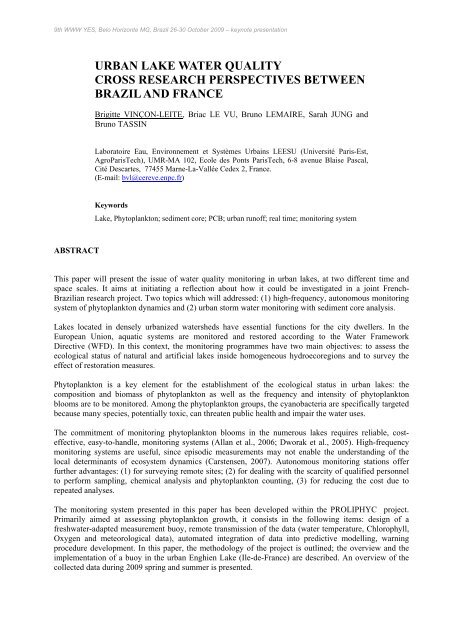

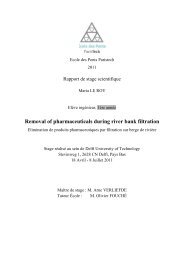
![[pastel-00730831, v1] Incidence des pratiques d'entretien ... - LEESU](https://img.yumpu.com/50938896/1/184x260/pastel-00730831-v1-incidence-des-pratiques-dentretien-leesu.jpg?quality=85)

